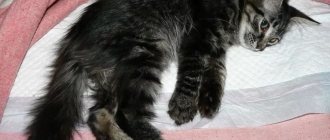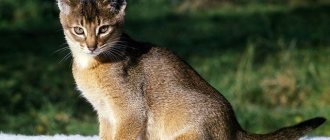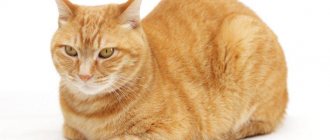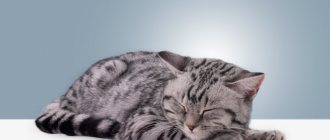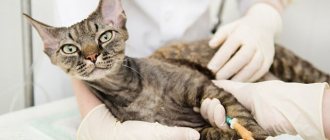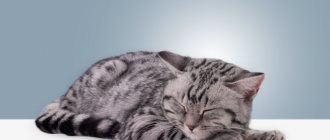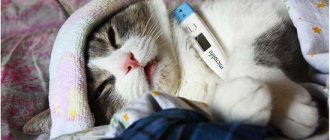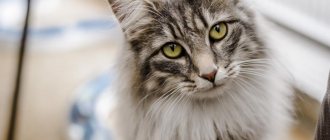A New York veterinary hospital keeps the medical history of the cat Sabrina, who, after falling from the 32nd floor, remained alive with a broken tooth and other minor injuries. At first glance, this fantastic story is not so surprising and certainly not unique.
If a person falls from a great height, he usually receives severe injury - fractures of the skull and spine, and severe internal bleeding may develop. It is rare that anyone survives a fall from a height of several floors.
How cats land on their feet
The question of cats falling has occupied physicists for a long time. Several approximate models have been proposed that could explain how cats manage to land on their feet. Scientists have come to the conclusion that this is, after all, a reflex, and not a special calculation of rotation at the beginning of the fall, as was commonly thought before. Here's what helps cats land safely:
- An excellently developed vestibular apparatus that controls the position of the body in space;
- When falling, cats spread their paws, increasing the surface area of their body, thereby turning into a small “parachute.” The falling speed does not exceed 100 km/h, regardless of the height from which the animal falls;
- To roll over, the cat first straightens its head and then bends its body in the middle. After which it turns over 180⁰ along its axis and again changes the bend of the body, compensating for the angular momentum that arises during rotation. Both halves of the body rotate, most likely synchronously. That is, the body bends, but does not twist;
- Before falling, the hind legs are aligned according to the position of the front ones;
- Before landing, cats arch their backs slightly and bend their paws so that the force of the blow is distributed across the tendons and muscles, softening the landing;
- The muscles of cats act as an excellent shock absorber, since in relation to the total body weight they are stronger than, for example, in humans.
By the way, according to research, when cats fall from a very high height, they still land not on their paws, but on their stomach. And tailless cats move in flight in the same way as tailed ones. Only for proper grouping they use their hind legs more. Deaf cats fall just as well as healthy ones, but blind cats behave less actively when falling.
"Falling Skater"
The French mathematician of the 17th-18th centuries, Antoine Paran, and after him James Clerk Maxwell, believed that a cat, which is already spinning at the moment of falling, can change the speed of its rotation by pulling or extending the full length of its paw, which changes its overall moment inertia. The explanation was already recorded in detail by William Gordon Stables.
“At the beginning of a fall from a height, the cat’s back is curved in a semicircle. Natural instinct prompts her, after she has flown a foot or two, to suddenly contract the muscles of her back and extend her paws; now her stomach arches and her back becomes concave, which changes the center of gravity and turns her body over; After this, the cat, in order to land on its paws, can only hold itself in this position.”
This explanation does not seem to be true: a cat in free fall is not attached to anything, which means that changing the position of its body does not affect its stability in any way. Additionally, scientists couldn't really notice all of the animal's movements because cats roll over too quickly. But soon photography came to the aid of people.
Cats in space
In the 1950-60s, during experiments to prepare for the launch of animals and humans into space, the behavior of cats in zero gravity was studied. It turned out that in zero gravity cats do not roll over, since there is no gravity there. Upon returning to the gravity field, the cat may roll over if it has spent no more than five seconds in weightlessness. Otherwise, the proportion of successful rollovers fell.
Thomas Kane, a professor of engineering mathematics at Stanford University, applied his mathematical methods to the falling cat problem. He created the most accurate model to date, which combines the Rademaker and Marey hypotheses. The study of cat movement was used to teach astronauts how to effectively change their body position in zero gravity.
Complex reflex
Equally important was the question of how the animal's brain controls the body's muscles to turn the cat over correctly. In 1916, Lewis Weed of Johns Hopkins University and his colleague Henry Mueller conducted the first neurobiological study of the cat reflex. They were not interested in the specific movements of the cat, but in how the nervous system initiates these movements.
The species “turned off” the cat’s cerebral hemispheres from the process - and saw that a cat lacking cerebral hemispheres does not exhibit a rollover reflex. This suggested that consciousness was required to flip in the air. In addition, Müller and Weed tried to understand how a cat determines which way to turn in order to land on its paws. They found that a blindfolded cat is able to roll over and land in the correct position, and a cat with a damaged vestibular system but functioning vision can do the same. But if you blindfold a cat and at the same time damage its vestibular apparatus, the cat will not even try to roll over. This means that the rollover reflex relies either on vision or on the sense of balance.
How do cats survive falling from great heights?
In addition to the ability to group, cats have a number of advantages that nature has endowed them with:
1. Skeleton. Flexible, lightweight bones coupled with their small size help cats remain more protected than other animals and people when falling from heights.
2. Resistance. Terminal velocity is the maximum speed an object reaches as it falls. It can be reduced by increasing drag, which is air resistance that can slow an object down. Cats have increased resistance due to the way they move their limbs when falling. Also resistance increases wool. This is why furry cats are more protected when falling from a height.
3. Paws. A cat's paws are strong and muscular. They help cats move unnoticed and also soften falls by acting as shock absorbers. The force of the blow is distributed between the four limbs and allows you to protect the body.
4. Tail. It can help stabilize the body when falling. Short-tailed and tailless cats do not have this advantage, but this does not affect the righting reflex itself.
From the thirty-second floor
But here's another interesting problem: it turns out that cats don't just fall unharmed from heights - when falling from really high heights, they are even more likely to survive. Cats have fallen from 19 and even 32 floors, sometimes suffering only minor injuries. Veterinarians wondered why this was happening. They suggested that the cat, until it reaches a stable speed (about 100 km/h, since its body is small), experiences acceleration and reflexively extends its paws, making them more vulnerable.
But when a constant speed is achieved, the vestibular apparatus ceases to be excited, the cat relaxes and moves its paws to a horizontal position, gliding like a flying squirrel. She also arches her back, causing air to pool under her belly, creating a parachute effect that slows her speed. As a result, the impact force is more evenly distributed throughout the body.
Landing mechanism
Experiments with cats falling were carried out two centuries ago by French researchers. They changed the height, released the cat and analyzed its movements. For a long time it was believed that the tail was responsible for landing on four paws, because it was considered a kind of rudder. But later it turned out that even without a tail, the cat always lands on its paws.
Regardless of the position in which the fall begins, in a very short time the cat's body turns around and aligns itself with the ground. In more detail it looks like this
Bottom line: all cats do it differently!
Why is the issue of turning a cat over so difficult? People tend to look for a “single reason” for what is happening, but nature’s task is completely different: it needs not the simplest, but the most effective solution. This best solution may involve several behaviors or several movements linked together. The cat does not have to choose just one method of turning over, but can use all methods available to it to optimize the outcome. That's why different cats do it slightly differently, depending on size, build, condition, whether they have a tail, and other factors.
Book we recommend:
Gregory Gbur "The Mystery of the Falling Cat and Fundamental Physics"
In his fascinating and witty book, physicist and avid cat lover Gregory Gbour shows how attempts to understand the mechanics of falling cats have helped to understand a variety of problems in mathematics, physics, physiology, neuroscience and space biology, contributed to the development of photography and cinema, and influenced even robotics.
The Mystery of the Falling Cat and Fundamental Physics
Gregory Gbur
"Push up and turn around"
Physician and photographer Etienne-Jules Marey recorded all stages of a cat's fall in photographs. When the French Academy saw these photos, they couldn’t believe their eyes. How can a cat turn itself half a turn without a support point? Maybe she was pushing off from the window sill or the hand that dropped her? But no, Marey's photographs clearly showed that the revolution begins only when the cat is already in free flight and does not have any objects nearby from which it could push off.
Mathematician Emile Guillou proposed the following model of what is happening: a cat, with the help of its front and hind legs, controls the moment of inertia of the front and rear parts of the body. First, he stretches out his hind legs and picks up his front legs (and now the upper part is already correctly oriented), then he picks up his hind legs, stretches out his front legs and “twists” the lower part to the correct orientation, without turning the upper part, which is already in the correct position.
"Fold and Spin"
German researcher Rudolf Magnus proposed that the cat's flip is controlled by a set of orientation reflexes that are triggered by turning the head. And the acceleration of the labyrinth, the area where the vestibular system is located, forces the cat to start turning.
A student of Magnus Rademaker discovered, however, that the cat rolls over into the correct position and lands on its paws, regardless of what position its head was originally in. In 1935, he proposed another realistic model of what happens to a cat when it falls. By folding at the waist, the cat can rotate the two sections of its body in opposite directions, thereby canceling out their angular momentum.
The question remained: how does a cat know which way is up when it starts to fall? In free fall, a cat does not experience any force that its vestibular apparatus could use for orientation. Vision has nothing to do with it: a blindfolded cat also turns over.
Spine
Flying kittens
In addition to muscles, successful flight also depends on the flexibility of the joints of the spine. A cat, unlike a person, has a large number of spinal links (a cat has thirty of them, while a person has 24). This makes the cat's spine elastic, and that is why the animal can so elegantly and gracefully arch its back in a way that a person is not able to do.
A remarkably developed vestibular apparatus allows a cat that falls to the ground to navigate its surroundings, intuitively assess its own chances and bring its body into the most favorable position for landing.
A cat is a fairly small and light animal. Its weight relative to the area of the body is much less than that of a person. This also contributes to the ability to correctly group the torso.
"Tail-propeller"
Mathematician Giuseppe Peano proposed a different mechanism: the cat twists its body, rotating its tail like a propeller. Having turned to the desired angle, the cat stops its tail, and thereby its own rotational movement, saving at the same time the essence and principle of areas. A cat's tail, however, weighs much less than itself, which means that the tail will have to make more than one revolution to turn the entire body over.
However, almost a century later, in 1989, J. E. Frederickson experimentally demonstrated that a tailless cat is perfectly capable of rolling over, although cats that do have tails do use them to aid the process.
Possible consequences
Independent experiments with cat abilities are fraught with dangerous consequences. You should not intentionally release an animal from a great height, otherwise instead of a successful landing, disaster may happen in front of the owner’s eyes :
- traumatic brain injuries;
- ruptures of internal organs;
- fractures, dislocations;
- hematomas, lacerations;
- shock.
Older animals often have problems with the musculoskeletal system, so for them a fall from a height can be fatal. But all negative circumstances are nothing more than an exception. Every cat, 3-4 weeks after birth, a priori knows how to land correctly.
Every person, at least once in his life, wonders why cats land on their paws? Despite the fact that this phenomenon is easily explained in terms of the physiology of the cat family, for most people it is nothing more than a unique and inimitable ability. Cats are amazing animals that will never cease to amaze and captivate humanity.
Previous
Question and answer Normal creatinine levels in urine in cats
Next
Question and answer: Can cats swim?
Great article
Causes of cats falling
If a cat just falls like that, this is not normal. Although the cause of this behavior could be something fairly harmless, it is important to become aware of some possible explanations. The more you know about these options, the easier it will be to care for your feline friend.
© shutterstock
Neurological problems
Cats can develop brain problems that can cause a variety of unusual behaviors, including seizures or just falling out of nowhere. These problems are often very serious and life-threatening. Unfortunately, there is little that can be done about neurological disorders in cats.
Ataxia
A condition known as ataxia can also cause a cat to fall. There are many different reasons that can cause this, from neurological problems to cancer. An experienced veterinarian will likely be able to determine the cause of this condition. Sometimes ataxia can be the result of a fungal infection, in which case it is likely to be fairly easy to treat with medication. Your veterinarian will likely run several tests to narrow down your options.
Ear infection
A simple ear infection in your cat can cause her to collapse. Infections affecting the inner ear can disrupt the animal's balance. This can happen even to experienced balancers such as cats.
Some of the most common symptoms of an ear infection in cats include:
- accumulation of wax in the ear,
- hearing loss,
- yellow discharge from the ear,
- tumor of the ear canal.
If you notice these symptoms in your cat, contact your veterinarian immediately. It is important to get the infection under control before it gets worse. Your veterinarian will likely prescribe special medicated ear drops to help clear up the infection.
Anemia
Cats suffering from metabolic disorders, such as anemia, are also prone to falling. This is actually a fairly common condition in these animals. Cats can develop different types of anemia, some of which are potentially life-threatening.
Some of the common symptoms of anemia in cats include:
- Pale gums
- Sudden weight loss
- Black tarry stool
- Cardiopalmus
- Lethargic behavior
Fortunately, anemia is usually treatable and can be managed effectively with the right medications. The sooner you get your cat checked by a veterinarian, the better off she will be overall.
© shutterstock
Hypoglycemia
Hypoglycemia, also known as low blood sugar, is another possible explanation for your cat's occasional falls. This is not usually an immediate life-threatening problem, but it needs to be addressed immediately.
A cat may develop low blood sugar as a result of illness or infection. It is also possible that you are giving your diabetic cat too much insulin. This can become a problem if you forget to feed your cat.
Some of the other symptoms of low blood sugar in your cat:
- Lack of appetite
- Blurred vision
- Muscle weakness
- Loss of consciousness
- Anxiety
- Tremor
If hypoglycemia is allowed to progress far enough, it can even cause seizures and blindness. This is just one reason why you need to constantly feed your cat. If your kitten has diabetes, you should administer the correct amount of insulin daily.
How to prevent a fall?
Unfortunately, not all cats are lucky enough to survive a fall without injury. There are several reasons for this. Many pets are overweight and not in the best physical shape. It will be much more difficult for them to group while falling. The same applies to older pets or animals with diseased bones and joints. The chances of such cats falling painlessly also decrease sharply. Finally, if a cat falls from a window, it may stumble upon someone else’s balcony, sharp metal structures, and other deadly obstacles. City animals rarely manage to survive by accidentally jumping from a windowsill after a bird or a fly. To protect your pet from falling, follow these simple rules:
- Install anti-cat nets or protective grilles on windows. Mosquito nets are not suitable: they are too thin and can break under the weight of the cat.
- Place side restraints on the windows to prevent your pet from getting stuck trying to jump out through the “top ventilation.”
- Do not wash windows in the presence of a cat. Temporarily shield yourself from your curious pet or lock him in a safe place, giving him free access to food, water and a litter box.
- Teach yourself and your children not to throw the cat on the floor, but to place it carefully.
Photo:
Other Amazing Abilities
In addition to the ability to fall correctly, representatives of the cat family demonstrate other amazing abilities.
Ability to fit in any container
The cat easily places its body in small boxes, vases, dishes and other containers unsuitable for such use. Moreover, the unnatural position of the body does not cause any discomfort to the animal.
Treatment of hosts
Cats are true natural healers. They always subtly sense the condition of their owners and try to lie down on the place that hurts. Their positive impact on the psychological state of people leaves no doubt.
Premonition of Trouble
Numerous cases confirm the fact that cats are able to anticipate natural disasters, catastrophes that threaten misfortune to a person. Foresight is explained by the subtle intuition inherent in these animals and well-developed hearing. Thus, during the Second World War, people under fire often relied on the behavior of their pets. The approaching bombers were indicated by a change in the cats' behavior: they began to worry and look for cover. In addition, a strong energetic connection is often established between the cat and the owner, as a result of which the animal senses the illness and approaching death of the person.
